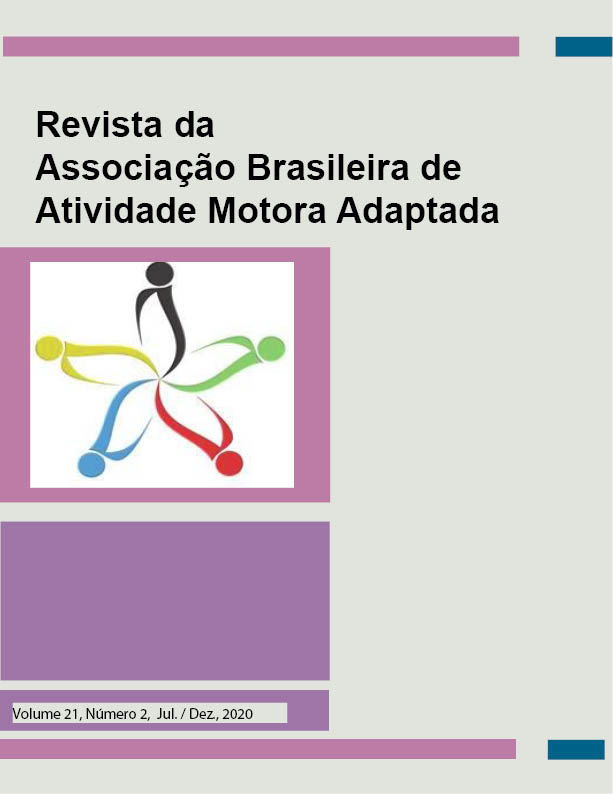CLASSIFICATION OF GREAT MOTOR FUNCTION OF STUDENTS
DOI:
https://doi.org/10.36311/2674-8681.2020.v21n2.p237-256Keywords:
Keywords: Cerebral Palsy; Motor Performance; GMFCS.Abstract
Cerebral Palsy (CP) is a disorder that occurs as a result of injury to the Central Nervous System (CNS) that can occur in the prenatal, peri-natal and post-natal periods. The research aims to classify motor function according to levels of functionality in students with cerebral palsy. As a research instrument, the Gross Motor Function Classification System (GMFCS) was used, with the purpose of identifying the motor functionality of children and adolescents, determining the level that represents the current abilities and functional limitations of each individual. The sample consists of 10 children and adolescents of both sexes, with heterogeneous characteristics of the clinical picture diagnosed with CP. The results show that 40% of students had motor function classified at level 2, about 30% were classified at level 3 and another 30% at level 5. Therefore, most students are independent in their functionality, in view of the level for each age, but who at some point may need help from someone else. While others, in addition to needing help from someone else, also make use of assistive technology, they are therefore totally dependent. In this way, we conclude that the GMFCS is a good indicator of functionality, since from the established levels it is directed to choices of assessments, planning of motor activities and interventions.
References
BRASIL. Diretrizes de atenção à pessoa com paralisia cerebral. 2013.
DIAS, A. C. B et al. Desempenho funcional na paralisia cerebral. Fisioterapia e Pesquisa, São Paulo, v.17, n.3, p.225 - 9, jul/set. 2010.
FISS, A. L et al. Developmental trajectories for the early clinical assessment of balance by gross motor function classification system level for children with cerebral palsy. Physical therapy, v. 99, n. 2, p. 217, 2019.
GRAHAM, HK et al. Cerebral palsy. Nat Rev Dis. Primers [internet]. 2016; 2(15082):1-25. DOI: https://doi.org/10.1038/nrdp.2015.82 2.
HADJINICOLAOU, AMD et al. Is Cerebral Plasy Changing in High Resource Settings? Data From the Quebec Cerebral Palsy Registry. Journal of Child Neurology. (34):10, 2019
HIMMELMANN, K et al. Gross and fine motor function and accompanying impairments in cerebral palsy. Dev Med Child Neurol. 2006;48(6):417-23.
HIRATUKA, E.; MATSUKURA, T. S.; PFEIFER, L. I. Adaptação transcultural para o Brasil do sistema de classificação da função motora grossa (GMFCS). Brazilian Journal of Physical Therapy, v. 14, n. 6, p. 537-544, 2010.
KENJI, A et al. 49 perguntas sobre paralisia cerebral. São Paulo: Manoele, 2017.
LAKATOS, E. M.; MARCONI, M. de A. Fundamentos de metodologia científica: Técnicas de pesquisa, v. 7, p. 166, 2010.
LANFREDI, APA et al. Nível de habilidade motora funcional em crianças com paralisia cerebral. Reabil. 2004,25(6):20-3.
MARCONI, M. de A.; LAKATOS, E. M. Fundamentos de metodologia cientifica - 7. Ed. – São Paulo: Atlas, 2010.
MARINHO, APS.; SOUZA, MAB; PIMENTEL, AM. Desempenho funcional de crianças com paralisia cerebral diparéticas e hemiparéicas. Rev Ciênc Méd Biol. Salvador. 2008;7(1):57-66
OLIVEIRA, A. I. A; MO, G; MCB, C. Aplicabilidade do Sistema de Classificação da Função Motora Grossa (GMFCS) na paralisia cerebral – revisão da literatura. Arq. Bras. Ciên. Saúde. V.35, n.3, p.220-24, 2010.
PALISANO, R et al. Development and reliability of a system to classify gross motor function in children with cerebral palsy. Dev Med Child Neurol. 1997;39(4):214-23.
PALISANO, R et al. GMFCS-E&R. CanChild Centre for Childhood Disability Research, McMaster University, 2007.
ROSA, A. C. A.; MATOS, M. R. Classificação funcional de indivíduos com paralisia cerebral de acordo com a escala de avaliação GMFCS. Rev Univap [Internet], v. 22, n. 40, p. 1-4, 2017.
ROSENBAUM, P et al. A report: the definition and classification of cerebral palsy april 2006. Developmental Medicine and Child Neurology, [S.l.], v. 49, n. 2, p. 8-14, 2007.
SANTOS, BAS et al. The impact of cerebral palsy diagnosis from the perspective of the family. REME rev. min. Enferm. [internet]. 2019; 23:e-1187.




